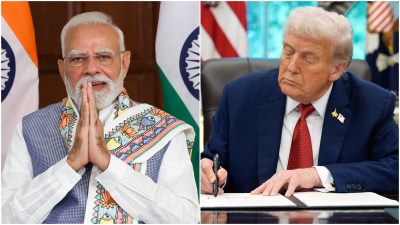Vanya Vaidehi Bhargav’s biography of Lala Lajpat Rai breaks the pigeonholes he has been hemmed in
The book challenges the claims that the leader was a "Hindu hero" as well as that his was an "Indian nationalism" with a "communal twist"
 Bhargav begins her author’s note by saying that she has “long harboured the passion to write history that is accessible to the public” (Amazon.in)
Bhargav begins her author’s note by saying that she has “long harboured the passion to write history that is accessible to the public” (Amazon.in)At a time when Savarkar’s Hindutva seems to be in vogue, many scholars have looked for alternative articulations of nationalism. Vanya Vaidehi Bhargav’s Being Hindu, Being Indian does exactly that, by presenting a systematic study of Lala Lajpat Rai’s diverse, seemingly contradictory ideas on the subject.
Rai has long been viewed as an intellectual predecessor of Savarkar, and, as Christophe Jaffrelot put it, “a pioneer of Hindu nationalist ideology”. This characterisation, Bhargav argues, is in line with the Hindu Right’s claims over Rai’s legacy of being a “Hindu hero”, in opposition to the Indian National Congress’s brand of secular — “pro-Muslim, anti-Hindu” — nationalism.
Being Hindu, Being Indian challenges this interpretation, which Bhargav believes “ends up leaving out much nuance”. At the same time, it also seeks to resist the tendency to simply ignore Rai’s Hindu nationalism in favour of casting his thoughts as a form of “Indian nationalism”, albeit with a “communal twist” (as articulated by historian Gyanendra Pandey in The Construction of Communalism in Colonial North India, 2006). Bhargav’s book is an attempt to extricate Rai from the pigeonholes that he has been hemmed in, to map out the fluidity and evolution of his thought, and in the process “convey some sense of how complex history can be”.
Bhargav begins her author’s note by saying that she has “long harboured the passion to write history that is accessible to the public”. In this regard, she does not disappoint. At the same time, her endeavour to write for the layperson does not come at the cost of scholarly rigour. Her writing is lucid, sensitive to detail and resists the temptation to be sensational. Bhargav is also not afraid to theorise but does so with the research to back it up.
At a time when dime-a-dozen pop historians write shoddily researched empirically-disconnected bestsellers, Being Hindu, Being Indian is a much-needed work, exactly the kind to counter WhatsApp histories — something Indian academics have generally not been good at. It’s not the first book in this space, but definitely among the better ones.
It’s also a timely book because it challenges the notion that nationalism, or, for that matter, Hindu nationalism, is a monolithic ideology. Bhargav’s study of Rai’s alternative vision of what it means to be a Hindu, and an Indian, presents a foil to the homogenising Hindutva that India’s current dispensation pushes.
The book is divided into four chronological parts, “covering nationalist narratives that Lajpat Rai articulated in four distinguishable phases of his intellectual life” — from the 1880s, at the beginning of Rai’s political life, to the 1920s, when he was eventually killed by blows to his head from a British officer’s lathi. Chapters in the book are interspersed with historical narration and philosophical discussion, with Bhargav paying crucial attention to the political and intellectual circumstances in which Rai articulated his ideas.
Unfortunately, the book does not pay much attention to socio-economic processes to aid this contextualisation. One can’t help but think that a book proclaiming to shed light on history’s complexities would have done well with an added layer of context.
The bigger problem with the book is that, at times, the author’s quest to push through her basic argument seems forced — and not because of lack of empirical evidence: Bhargav leaves very little for the readers to discern. Rather than prodding readers towards the conclusion, Bhargav sometimes seems to be shoving it down their throats.
For instance, in Chapter 20 (‘Understanding Lajpat Rai’s Hindu Politics and Secularism’), arguably the most important chapter in the book, the author makes a single overarching point: that Rai’s militant Hindu politics was very much compatible with his convictions towards a secular nation state. Whether one agrees or disagrees with this claim — Bhargav certainly presents a very compelling case — this feels repetitive, especially given the content of all previous chapters put together. The book might have been much more powerful if it had, at least in some cases, left readers with the opportunity to draw their own conclusions.
This also sometimes leads to the author glossing over legitimate criticisms of Rai. It is not that Bhargav does not make these criticisms. But given how ardent she is in articulating that Rai’s Hindu and secular nationalisms are very much compatible, the book seems to find ways to minimise these criticisms for the service of the larger point being made. In other words, in a bid to not be reductive (as historians thus far have been), Bhargav engages in a kind of reductionism of her own.
That being said, the book is a worthwhile read, if not for anything else, then to learn about the man often remembered as a part of the Lal-Bal-Pal triumvirate, or as the catalyst for Bhagat Singh’s murder of policeman John Saunders.





- 01
- 02
- 03
- 04
- 05

























